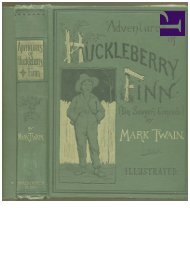You also want an ePaper? Increase the reach of your titles
YUMPU automatically turns print PDFs into web optimized ePapers that Google loves.
interesting, required volunteers, the bulk of them young men. Who might otherwise be,<br />
for instance, skateboarding, or at least wearing clothing suggestive of skateboarding. And<br />
male streetwear generally, over the past fifty years or so, she said, had been more heavily<br />
influenced by the design of military clothing than by anything else. The bulk of the<br />
underlying design code of the twenty-first-century male street was the code of the<br />
previous midcentury’s military wear, most of it American. The rest of it was work wear,<br />
most of that American as well, whose manufacture had coevolved with the manufacture<br />
of military clothing, sharing elements of the same design code, and team sportswear.<br />
But now, according to the French girl, that had reversed itself. The military needed<br />
clothing that would appeal to those it needed to recruit. Every American service branch,<br />
she said, illustrating each with a PowerPoint slide, had its own distinctive pattern of<br />
camouflage. The Marine Corps, she said, had made quite a point of patenting theirs (up<br />
close, Milgrim had found it too jazzy).<br />
There was a law in America that prohibited the manufacture of American military<br />
clothing abroad.<br />
And that was where Bigend, Milgrim knew, hoped to come in. Things that were<br />
manufactured in America didn’t necessarily have to be designed there. Outerwear and<br />
sporting-goods manufacturers, along with a few specialist uniform manufacturers,<br />
competed for contracts to manufacture clothing for the U.S. military, but that clothing had<br />
previously been designed by the U.S. military. Who now, the French girl had said,<br />
somewhat breathlessly, as though she were closing in on a small animal in some forest<br />
clearing, clearly lacked the newly requisite design skills to do that. Having invented so<br />
much of contemporary masculine cool in the midcentury, they found themselves<br />
competing with their own historical product, reiterated as streetwear. They needed help,<br />
the French girl had said, her mouse clicks summoning a closing flurry of images, and<br />
they knew it.<br />
He sipped his latte, looking out, watching people pass, wondering if he could see the<br />
French girl’s thesis proven in the garments of this morning’s pedestrians. If you thought<br />
of it as a kind of pervasive subtext, he decided, you could.<br />
“Excuse me. Would you mind if I shared the table?”<br />
Milgrim looked up at this smiling American, ethnically Chinese, in her black sweatshirt,<br />
a small plain gold cross, gold-chained, worn atop it, one white plastic barrette visible, as<br />
some unsleeping module of addict street-alertness, hardwired to his very core, crisply<br />
announced: cop.<br />
He blinked. “Of course. You’re welcome.” Feeling muscles in his thighs bunching,<br />
tight, readying themselves for the dash out the door. Malfunction, he told the module.<br />
Post-acute withdrawal syndrome. Flashback: His limbic brain was grooved for this, like<br />
the tracks of the wheels of Conestoga wagons, worn ankle-deep in sandstone.<br />
She put her sacklike white pleather purse on the table, her plastic-lidded pale blue Caffè<br />
Nero cup beside it, pulled out the chair opposite him, and sat. Smiled.



